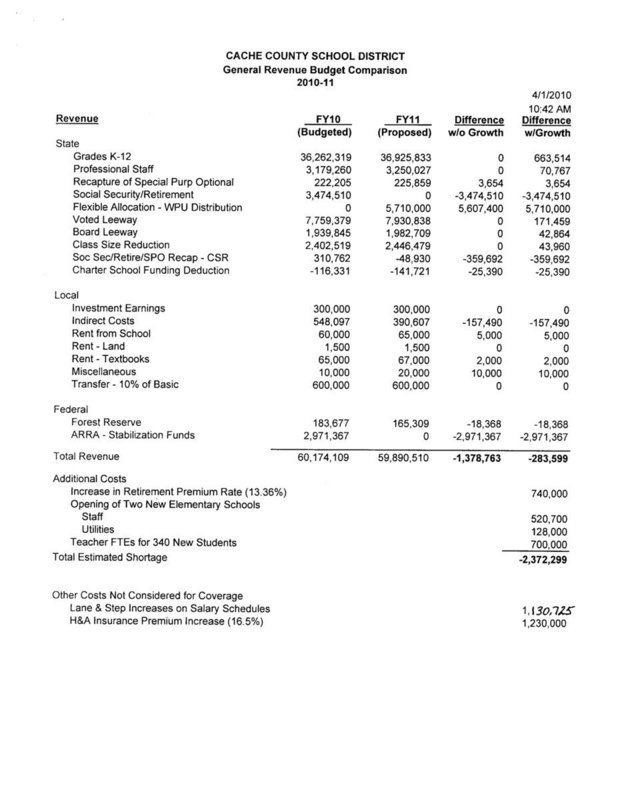Cache school district faces deep cuts in 2010-11 budget
Budget comparison (CCSD)
The Cache school district faces a $2.4 to $4.7 million shortfall for the 2010-11 school year. Thursday evening the Cache board of education began discussing spending cuts and possible tax increases to cover the shortfall.
The estimated shortage is from:
- A 13.36% increase in retirement premiums — $740,000
- Staff and utilities for two new elementary schools — $648,700
- Teachers for 340 new students — $700,000
The total estimated shortage is $2,372,299
Two additional costs not considered in the original estimate made on April 1:
- Lane and step increases to salaries — $1,130,725
- H&A insurance premium increase of 16.5% — $1,230,000
To cover all these expenses the shortage increases to $4,733,024.
A proposed series of cuts would decrease the budget by $2.4 million. Among these cuts include textbook adoption, children’s theater, teacher travel, principal travel (conventions), core academy registration, legal services, media specialists. However the largest savings would be not to hire new teachers to cover the student population increase. This would save $1.15 million but would also increase the student to teacher ratio an average of one student.
Mike Liechty pointed out that they made a quarter-student increase in the student to teacher ratio years ago and only recently recovered from that decision. Now the proposed student/teacher ratio would be increased by four times that amount.
Step increases
Adding to the problem is the step and lane increases in salaries for teachers, administrators and classified employees. These are part of a set pay schedule of increases the employees receive each year. It is based on seniority and part of the employment program. These are not the same as cost-of-living raises also considered by the school.
To cover the $1.13 million for the step and lane raises, the district would need to consider even more cuts, or possibly increase taxes.
For example, the district could increase class sizes, again, by one-student to cover $1.15 million in expenses. However, this time that would double the class size ratio by 2 if you do it both for the shortfall listed above and the step increases. This would also result in layoffs in the district. Instead of just not hiring new teachers the district would have to let teachers go.
Other options considered:
- A 1% reduction in all salaries
- Elimination of three school days
- Increase the special transportation tax rate
- Institute a recreation tax levy
- Transfer capital outlay funds to the general fund
Board members were justly concerned about all these options and what to do about them. For example, Board President Jonathan Jenkins said he didn’t like the idea of cutting everyone’s pay by one percent just so they could cover pay increases for other employees.
It is also understood that these step and lane increases are very important to the district employees and cutting them would not be easy.
Taxes
District Business Administrator, Dale Hansen, said property taxes for the Cache School District are lower than the state average. However, Cache is 4th lowest district in taxable property values. He listed the school’s tax options which get fairly complicated.
For example, the Voted Leeway tax was originally set three years ago to 0.001600. The rate has decreased to 0.001452. This is due to increasing real estate values. So although the rate decreased, the amount paid by property owners remained the same. The state pays the district matching equalization funds which will not decrease for five years after the rate was set. If the district fails to re-raise the rate back to 0.001600, they will lose money from the state equalization funds.
This simple increase would add $15 to the property tax of a $185,000 residence and add $527,558 to the district funds. If they do not pass the increase, in two more years they will need to pass the increase or face losing vital state funds.
This is one of six tax options the district could consider (see Property Tax Options document).
No easy answers
The district has an online presentation regarding the school budgets and the challenges facing the district for next year. If you haven’t seen the presentation, it is highly recommended.
A questionnaire is attached to the presentation where you are allowed to express your opinion on what the district should do about the shortfall. Norton passed out copies of the survey to the school board that have already been filled out by area residents.
The school board meets again next Thursday in a study session to discuss the budget options.
Retirement benefits
In other business, the board voted to change the retirement health benefit. Formerly the school district would pay for four-years of health insurance for retired employees. Now the district will make a one-time payment at retirement of $20,000 to $30,000 to a tax sheltered trust account. The retiree can choose to move the money, tax free, into a health savings account or other tax deferred account.
The district would be in charge of the trust accounts and in the unlikely benefit of the retiree dying without a beneficiary, the school will give the remaining portion, if any, to the retiree’s estate.
The payout amount is based on years of service with a minimum of 20-years required to qualify.
The change will be phased in over three years. During the transition retiring employees can choose either four years of coverage or the one-time payout. Kirk McRae said the proposal was already ratified by the employees. The board passed it unanimously.
Cyber bullying
Kirk McRae presented an update to the district’s bullying policy which included language on bullying, hazing, and cyber bullying. Board Member Richard Knight asked about the cyber bullying provision which defined bullying as physical threats against a person or property. “What about psychological threats?” asked Knight.
McRae said the policy definitions came from the State’s model policy. Plus psychological threats are can take a lot of shapes and forms. From an enforcement standpoint it would be difficult to determine what constitutes a psychological threat. “It may shut down all types of cyber-interaction with students,” said McRae.
“Every school is required to come up with their own bullying plan,” added McRae. “This is just an umbrella for them to follow. For an elementary school it will be different than a high school. And anything that falls into a criminal type behavior will involve law enforcement.”
Superintendent Steven Norton added that the bullying provision was worded quite strongly where it said bullying is to “deliberately harass, threaten, or intimate.” He said they could simply state the definition and drop the physical requirement from the policy.
The board also discussed the jurisdiction of the school in bullying on or off property. “I don’t see any difference between a kid making another kid miserable at school versus making their life miserable at home or via cyber bullying,” said Norton.
It is clear that the board and administrators all want a policy to end bullying and hazing in the district. They want the policy broad enough to account for more than just physical threats. “I think we need to leave a little wiggle room,” said board member Tamara Grange. “To leave some initiative for the principals and not make it too tight so they can’t use common sense.”
The board passed an amended policy which defined bullying as “deliberately harass, threaten or intimidate” and they removed the physical requirements from the cyber bullying section.
Elementary schools named
Trudy Wilson, principal of the new Smithfield elementary school, described the process of selecting a name for the school. Letters were sent to parents in the school boundaries. They received back 100 ballots with ideas for the name and school colors. A selection committee narrowed the entries down to nine. They held a public hearing on April 15 where the names were narrowed to four — Birch Creek, Creekside, Sunset and Forrester with Birch Creek being the most popular.
The board approved the new name — Birch Creek Elementary School.
The new Nibley elementary school principal, Gary Thomas, said they had three names from their meetings with parents — Heritage, Blacksmith and Elk Horn. They selected the most popular name to present to the school board — Heritage Elementary School. Board member Allen Grunig expressed concern that the name would be confused with a private school similarly named. It was decided that since this would be the only school named “Heritage” in the valley, it probably wouldn’t be confusing.
The board approved Heritage Elementary School as the name of the Nibley school.
School fees
The board adopted a revised student fee schedule. No changes were made for Kindergarten through fifth grade. For sixth grade, the instrument rental fee increased $5 from $70 to $75. In eighth grade they are eliminating the calculator repair and replacement fee and they are increasing the instrument rental fee to $75. In ninth grade, the calculator, technology and piano fees are all eliminated. For high school they eliminated the flash drive fee. They also cut all lodging and travel costs for pre-season athletic events. Only post-season region and state events will be paid for.
Deputy services renewed
The board renewed their contract with the Cache County Sheriff’s office for two reserve deputies to work as resource officers for the district. The school will pay $145,000 for the school year which is the same rate the school paid for the past two years — same services for the same price.

